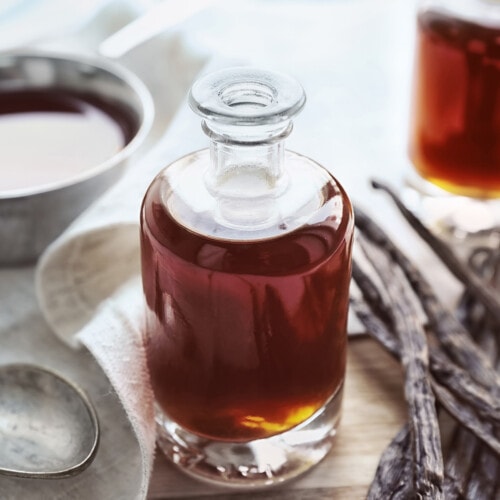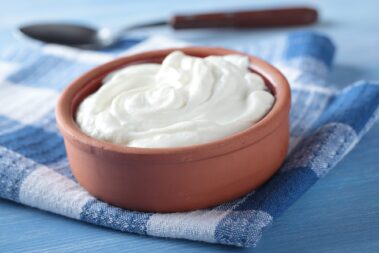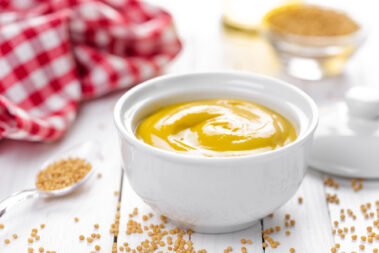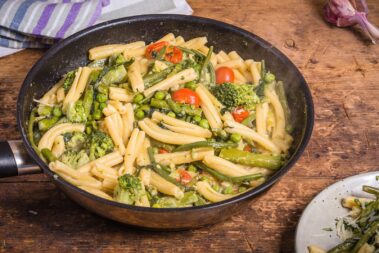Is vanilla extract vegan? Yes, vanilla extract, whether made from real vanilla or artificial ingredients, is vegan.
But why, then, are so many people concerned that vanilla isn’t safe for vegans to eat? Well, the answer lies with a strange substance known as castoreum—a decidedly unvegan and nearly not-safe-for-work flavoring extract.
Keep reading to find out more!
Table of Contents
How Is Vanilla Extract Made?
Like other extracts, vanilla extract is made by soaking a solid product in a mixture of alcohol and water. In this case, that solid product is made up of aged vanilla bean pods.
The vanilla beans in these pods contain a molecule called vanillin. This is what gives vanilla its signature smell and flavor. Aging the beans, which involves keeping them in a hot, humid environment for several days, increases the concentration of vanillin.
The alcohol mixture helps pull this flavoring from the dried beans along with that signature brown coloring and other compounds that lend themselves to the final flavor of the product.
It can take up to 12 months for vanilla extract to cure (though our recipe below only takes 1 month). Commercial manufacturers are able to manipulate the environment to reduce this time period considerably.
Once the mixture has cured, the solids are filtered out and the liquid that remains is bottled and sold. To meet FDA regulations, pure vanilla extract must contain at least 35% alcohol and 13.35 ounces of vanilla beans per gallon or 100 grams per liter.
Water, alcohol, and vanilla beans are the main ingredients in real vanilla extract. Though, some manufacturers will add corn syrup or other sweeteners to the final product.
What Is Castoreum?
Castoreum is not made from vanilla beans or even remotely related to it. But it does have a strong scent and flavor reminiscent of vanilla. Which is pretty strange, considering it comes from the scent glands under a beaver’s tail.
You read that right. Castoreum is a thick brown goo that is harvested from the anal glands on the bums of beavers.
The vanilla-y flavor of the goo is a product of the beaver’s diet. Their preference for wood pulp means they eat a ton of guaiacol, a chemical precursor to vanillin.
During the frontier days, castoreum was fairly easy to come by, and certainly much easier to find in North America than tropical vanilla orchids from Madagascar or Mexico. Adding some vanilla flavor to your favorite dessert was as easy as hitting up your local pelt hunter or beaver trapper for some castor sacs.
But even back then—and certainly today—castoreum was not used to create vanilla extract.
Pure Vanilla Extract vs Artificial Vanilla Extract
Whichever type of vanilla you chose, you can be sure your extract, whether it’s synthetic or pure, does not contain any beaver anal secretions.
If it’s labeled as pure vanilla extract, it abides by the FDA’s rules for vanilla bean concentration. There are plenty of great examples of pure vanilla products, such as Taylor & Colledge vanilla extract (they also have a great vanilla paste), Badia Pure Vanilla, and McCormick’s All Natural Pure Vanilla Extract.
If it’s an artificial vanilla extract (typically marketed as “vanilla flavoring,” “vanilla essence,” or “imitation vanilla extract”), then it likely contains synthetic vanillin made from the petrochemical precursor, guaiacol. This product of the petroleum industry accounts for 85% of vanillin used in food. Most of the rest of vanillin flavoring is derived from lignin, or wood pulp, which is naturally high in guaiacol.
Neither artificial extract nor extract made with real vanilla beans contains animal products. This means they’re both safe for vegans to consume. But, given that imitation vanilla is very likely to be a product of the petroleum industry, it is best for the Earth to steer clear of this option if possible.
Is Natural Vanilla Flavor Vegan?
So, if vanilla extract is always vegan and castoreum has nothing to do with vanilla extract, where does the confusion come from?
The answer likely has something to do with “natural vanilla flavor.”
“Natural flavors” are the scourge of vegans everywhere. That’s because this common ingredient list staple can be made of any number of substances, from plants to animal secretions. Natural vanilla flavor, in particular, has the potential to be made from beaver behinds.
“Organic vanilla flavoring” is less of a red flag. This product does come from vanilla beans (and organic beans, to boot) and does not contain animal products. But this ingredient list item is much less common.
Before you swear off vanilla-flavored anything forever, know that most food products with “natural vanilla flavor” listed on the ingredients list are not made with castoreum. Yes, real vanilla is pricey, but it is still a lot easier to come by than beaver bum goo.
In fact, only about 300 pounds of castoreum is produced annually (compared to about 2.6 million pounds of synthetic vanillin). And most of this is used in the perfume industry.
As a vegan, you are fairly safe eating food products that contain “natural vanilla flavor.” You are even safer eating things that are made using vanilla extract or vanilla beans.
What is less safe is buying a bottle of perfume that smells like vanilla or leather. These almost certainly contain castoreum.
FAQ
Is all vanilla extract vegan?
Yes, if you see “vanilla extract” on an ingredient label, you can assume it is vegan. This product is made from vanilla bean pods and high-proof alcohol, both of which are animal-ingredient-free.
What is a vegan substitute for vanilla extract?
Because vanilla extract is vegan, it’s safe to use it in vegan recipes. But, if you happen to be out, you can use maple syrup or almond extract as a substitute.
Is McCormick vanilla extract dairy-free?
McCormick’s, just like other vanilla extracts, is made using vanilla bean pods and alcohol and does not contain milk or dairy.
Our Favorite Recipes Featuring Vanilla Extract
Now that you know vanilla extract is safe to use in vegan cooking, here are some of our favorite recipes featuring this ingredient.
- Coconut Milk Whipped Cream – A simple and delicious vegan whipped cream option.
- Vegan Flaxseed Pancakes – The tastiest, healthiest flapjacks you’ve ever had.
- Vegan Chocolate Mousse – Get that satisfying, chocolatey taste with just a handful of plant-based ingredients.
- High Protein Baked Oatmeal – The perfect breakfast or snack.
- Pumpkin Fruit Dip – Pumpkin puree and vegan cream cheese with plenty of spices and vanilla.
If you like these vegan recipes, be sure to sign up for our newsletter to get more like this sent straight to your email.
Homemade Vanilla Extract Recipe
Who knew vanilla extract could be so confusing? Between the petroleum-derived synthetic products and the beaver bum flavorings, we wouldn’t blame you if you wanted to forego anything vanilla for the foreseeable future.
But, we think a much better solution is to make your own vanilla extract right at home. That way you can be sure the bottle doesn’t contain any oil or bum oil! Not only that, but it tastes pretty great in your favorite recipes and only takes 1 to 3 months to cure.
What’s your favorite way to use vanilla extract? Let us know in the comments below.

Vegan Vanilla Extract
Ingredients
- 1 cup vodka 250 ml
- 6 vanilla beans
Instructions
- Split each vanilla bean in half lengthwise using a sharp knife.
- Put your vanilla beans in a jar and add vodka, making sure the vanilla beans are completely covered.
- Close lid and store in a dark, cool place for at least a month. From time to time, stir the contents or shake your jar.
Notes
It’s up to you whether you want to remove the beans or leave them inside the jar once you start using the vanilla extract.
Recommended Tools & Products
Nutrition
- How to Pick the Perfect Watermelon For a Sweet Summer Treat - April 10, 2024
- Future Kind’s Foundations: A Multivitamin Made for Vegans - December 5, 2023
- Does Nutritional Yeast Go Bad? - November 28, 2023







